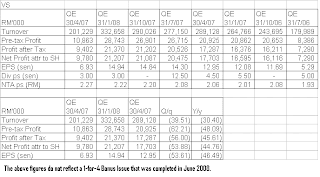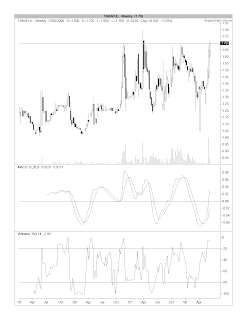Genting reported its results for 1Q2008 ending 31/3/2008 on May 29th. The net profit declined 14.6% q-o-q or 33.1% y-o-y to RM439.4 million. Turnover of RM2.164 billion was 6.6% higher than the same quarter last year, but 3.8% lower than the immediately preceding quarter.
The 33.1%-drop in net profit, when compared to the same quarter last year, was attributable to one-off gain recorded previously, such as the RM510.7 million net gain arising from the dilution of its shareholdings in Resorts World and Genting International PLC as well as a gain on dilution of RM63.2 million arising from Resorts World's investment in Star Cruises.
The 14.6%-drop in net profit, when compared to the immediately preceding quarter, was attributable to lower profits from the Leisure & Hospitality Division (due to lower visitors arrival in Genting Highlands Resort & its UK casinos) as well as the Plantation Division (due to lower FFB production).

Genting expects its results for the rest of its current financial year to be satisfactory due to anticipated increase in visitors to Genting Highlands Resort (in line with the Visit Malaysia Year promotion) as well as positive contribution from its Plantation Division. In its opinion, these should offset any negative impact from its Power Division (due to higher fuel prices) & continued weakness in its UK casino operation.
Technically speaking, Genting has broken below its immediate uptrend line support of RM6.15 about 4 weeks ago (see the weekly chart, Chart 1). The next supports are at RM5.20 (horizontal support) & RM4.50 (long-term uptrend line support) [see the monthly chart, Chart 2].
 Chart 1: Genting's weekly chart as at June 11th (source: Quickcharts)
Chart 1: Genting's weekly chart as at June 11th (source: Quickcharts) Chart 2: Genting's monthly chart as at June 11th (source: Quickcharts)
Chart 2: Genting's monthly chart as at June 11th (source: Quickcharts)While Genting's long-term uptrend line is still intact, its poorer results coupled with weaknesses in the equity market (due to both local & international factors) could lead to further downside for the share price. It is safer to let the stock test its next few support levels (especially the long-term uptrend line support of RM4.50) & to recover from it, before investing in this stock.

























